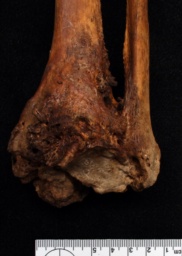

Reconsidering osteoarthri... (2019)
by Allysha P. Winburn


Single articular surfaces can also be observed and single age cutoffs generated based on OA presence/absence. Even if remains are insufficiently preserved to enable sex assessment, the combined-sex OA data presented herein could inform an age estimate for these fragmentary remains. However, in these cases of adverse preservation, the adage that "absence of evidence is not evidence of absence" must be kept in mind. When an incomplete skeleton is present for analysis, only the presence of OA should be considered conclusive evidence to inform an age estimate. Thus, if an isolated femur believed to originate from a European-American female exhibits extensive femoral head OA, the knowledge that in this population, 90% of females transition to exhibiting hip OA by 37.2 years could provide the lower terminus of an age range. Conversely, if this same femur exhibited no evidence of OA, this analysis would be inconclusive, as sufficient joint surfaces would not be present to generate an upper terminus. This issue of false negatives must also be discussed in terms of the current study. The preservation of the Bass Collection sample on which this study is based was excellent. Cases of unobservable joint surfaces were rare-and cases of damaged/missing joints surfaces in which the remaining joint surfaces showed no evidence of OA were even rarer. Thus, although scoring OA on incomplete remains can be problematic, it is unlikely that false negatives had a significant impact on the current findings.🏁
Global Leaderboard
| # | Player | Time | Duration | Accuracy | WPM | pp | |
|---|---|---|---|---|---|---|---|
| 1 | |||||||
| 2 | |||||||
| 3 | |||||||
| 4 | |||||||
| 5 | |||||||
| 6 | |||||||
| 7 | |||||||
| 8 | |||||||
| 9 | |||||||
| 10 |


Single articular surfaces can also be observed and single age cutoffs generated based on OA presence/absence. Even if remains are insufficiently preserved to enable sex assessment, the combined-sex OA data presented herein could inform an age estimate for these fragmentary remains. However, in these cases of adverse preservation, the adage that "absence of evidence is not evidence of absence" must be kept in mind. When an incomplete skeleton is present for analysis, only the presence of OA should be considered conclusive evidence to inform an age estimate. Thus, if an isolated femur believed to originate from a European-American female exhibits extensive femoral head OA, the knowledge that in this population, 90% of females transition to exhibiting hip OA by 37.2 years could provide the lower terminus of an age range. Conversely, if this same femur exhibited no evidence of OA, this analysis would be inconclusive, as sufficient joint surfaces would not be present to generate an upper terminus. This issue of false negatives must also be discussed in terms of the current study. The preservation of the Bass Collection sample on which this study is based was excellent. Cases of unobservable joint surfaces were rare-and cases of damaged/missing joints surfaces in which the remaining joint surfaces showed no evidence of OA were even rarer. Thus, although scoring OA on incomplete remains can be problematic, it is unlikely that false negatives had a significant impact on the current findings.🏁